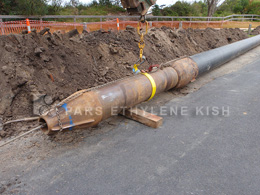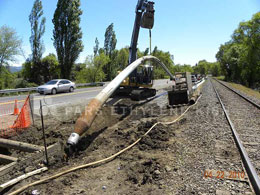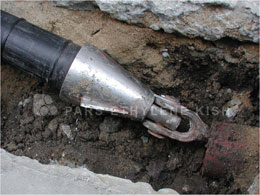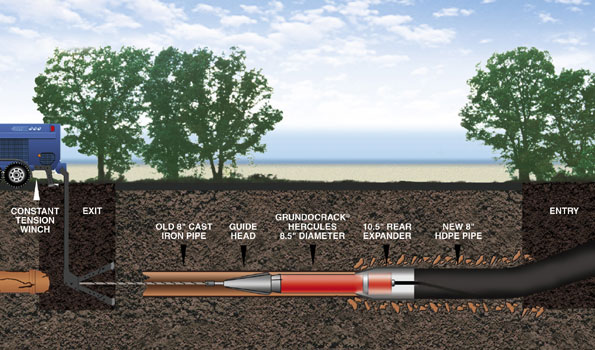As an increasing number of large diameter pipe bursting jobs are attempted, more is being learned about the capabilities and potential of pneumatic pipe bursting. The large diameter pipe bursting project in South San Francisco, CA is one of the most challenging and innovative bursting projects ever attempted in North America. It is being heralded as a landmark pipe bursting job. 
In 1999, the City of South San Francisco was confronted with a cease and desist order from the Regional Water Quality Control Board mandating the elimination of severe wet weather overflows within ten years. The City completed a comprehensive evaluation of their wastewater collection, conveyance, treatment, and disposal system. Locally deficient sewers, undersized pump stations, and hydraulic restrictions in the effluent outfall system were identified as the major contributors to the wet weather overflow problem. A five-phase program was developed to address these conditions.
Resolving the wet weather overflow problem was such a monumental task that many different elements were required. This massive “tool box” of solutions means that every presentation attendee should be able to take away valuable insights to benefit his or her own agency.
Project Background
Construction of the first phase of improvements has recently been completed. Recognizing the importance of making significant strides early in the program, the first phase was the largest project in the group. Phase 1 Wet Weather Improvements included:
-
Replacement of an existing pump station with a new 45-MGD pump station.
-
Construction of a new 49-MGD pump station located alongside an existing pump station.
-
Construction of 4,100 linear feet of 36-inch diameter force main (1,880 lf installed by pipe bursting from 27-inch to 36-inch); 6,860 linear feet of 42-inch diameter force main (525 lf installed by microtunneling); and 3,340 linear feet of 8-inch to 16-inch gravity sewer replacement (300 lf installed by horizontal directional drilling at Slope=0.0030).
-
Expansion of the effluent pump station to the fullest extent possible without constructing a new facility – 60 MGD.
-
Construction of a 7.5 million gallon effluent storage pond.
-
Addition of 30 MGD influent pumping capacity.
Design and construction challenges included construction sequencing, constrained sites, coordination with other projects, heavy rain and flooding during construction, soft, corrosive, and contaminated soils, high groundwater, congested utility corridors, heavy traffic, freeway crossings, and property issues. Initially, a route was chosen for the new force main to be constructed by traditional open-cut construction. Soils borings performed for the geotechnical investigation, however, identified a high potential for significant differential settlement and a need for extensive shoring that would include, at a minimum, interlocking sheet piles. The geotechnical engineer warned against constructing the force main by open-cut construction methods.
The design team then considered other alternatives for the force main. One part of the project involved constructing a new gravity sewer to replace a 27-inch diameter VCP sewer. An approach that involved utilizing the abandoned sewer as the host pipe for the new force main was developed. This approach would replace the 27-inch sewer with a 36-inch force main, installed using the pipe bursting process.
Pneumatic Pipe Bursting Background
Much of the pipe bursting completed in the United States is done with pneumatic tools. During pneumatic pipe bursting, the pipe bursting tool is guided through a fracturable host pipe by a constant tension winch. As the tool travels through the pipe, its percussive action effectively breaks apart the old pipe and displaces the fragments into the surrounding soil. Depending on the specific situation, the tool is equipped with an expander that displaces the host pipe fragments and makes room for the new pipe. As the tool makes its way through the host pipe, it simultaneously pulls in the new pipe, usually HDPE.
Scope Of Project 
The pipe bursting portion of the project called for replacement of 1,800 linear feet of existing 27-inch VCP gravity sewer with new 36-inch O.D. SDR 17 HDPE pipe by the pipe bursting methodology. The existing pipe was approximately 15 feet deep. Via this part of the project, the existing gravity sewer was converted into a sewer force main.
This was a significant undertaking due to a variety of factors. This project required a significant upsize, as it called for a large diameter host pipe. The host pipe also contained a large amount of debris that had to be removed before pipe bursting. The geology of the area itself presented a number of challenges, as well. The presence of Bay Mud with high groundwater conditions and aggressive soil proved to be difficult. In addition to the significant upsize and the difficult geology the crews had to work around; significant truck traffic, driveways, small businesses, warehouses, auto body shops, a concrete batch plant, etc.
These challenges were met head on through good coordination between the general contractor, the pipe bursting sub contractor, the equipment supplier, the engineer and the city. The contractor was well-qualified for pipe bursting work. The project designer stressed the importance that an experienced contractor be responsible for the pipe bursting work. The large upsize and the large diameter of the new pipe made this project an excellent example for other contemplating similar work. The principals of the contractor D’arcy & Harty and inspection personnel were involved onsite. Equipment manufacturer, TT Technologies, provided onsite technical assistance, which allowed technical problems to be resolved quickly. One of these problems was the specification change for static pipe bursting and then a return to pneumatic pipe bursting after the static method proved inadequate in the difficult geo-technical conditions.
The project required the connection of pipe segments after bursting operations utilizing Down Hole fusing of flanges and closure pieces. The combination of a qualified crew and reliable was able to achieve lengths of installed segments significantly longer than expected (420 If vs. 350 If = 20%). They also achieved an excellent installation rate of 200If/hr. The surface heave/settlement was controlled within acceptable limits as well. The equipment used in the project included: a 24-inch Taurus pipe bursting tool with a 42-inch rear expander, an 18-inch Goliath ramming tool to push the column of pipe, a 500-gallon Grundomudd system to provide polymer fore lubrication of the new pipe during bursting operations. Two 20-Ton Grundowinches were used, in tandem, to provide adequate constant tension force for this large pipe bursting tool. The project also required the use of support equipment including: large capacity air compressors and a water supply for mud system.
Lessons Learned
Such an aggressive program is expensive. Quality pipe materials, quality workmanship, and overall successful pipe bursting projects are attainable and are a benefit to all parties. Key specifications issues and customer acceptance should include a number of criteria.
First of all, it is important to clearly determine what issues or project problems exist and need to be addressed. No single pipe bursting technology will fit all situations. In some cases, compatible systems may provide the solution desired. It is up to the engineer or specifier to consider all variables in designing the pipe bursting project to ensure that the product or process will solve the existing needs without creating other problems. 
Specifications should clearly outline the project performance requirements and final goals. The specifications must also, accurately define project pipe bursting requirements, Contractor qualifications and required equipment submittals for pre-acceptance and approval by the Project Manager/Engineer. If the project includes incentives for completing the project ahead of schedule and under budget, they must be clearly spelled out within the project specifications along with contract completion requirements must be included in the project specifications including applicable testing and inspection, installation and product warrantees.
A quality control and safety plan that details performance criteria should be a required submittal by the Contractor. This plan should include: quality assurance requirements, testing, inspections and quality control documents during construction, must be specified, outlining the consequences and penalties. The contractor and product warranty should provide an installation warranty from the pipe manufacturer. It is also important to include periodic inspections of the complete project in conjunction with warranty periods. The longer the warranty, the more project inspections should be required. If any repairs or replacements are required for defects discovered during warranty inspections, they must be adequately defined within the project specifications and reiterated in warranty documentation. It is also important to note that, extended application warrantees will raise contractor risk resulting in higher project costs.
Before the project is underway locate all critical utilities during design so contractor can place pits,
identify important crossings, etc. Well written performance specifications, including QA/QC, testing and inspection requirements during construction will go significantly further in accomplishing quality pipe bursting projects. This is also true of utilizing adequate geotechnical engineering to verify that pipe bursting is the appropriate construction method and to allow contractor to properly select equipment, mobilize forces, and estimate production rates.
WESTT, Summer 2007
source : tttechnologies.com
